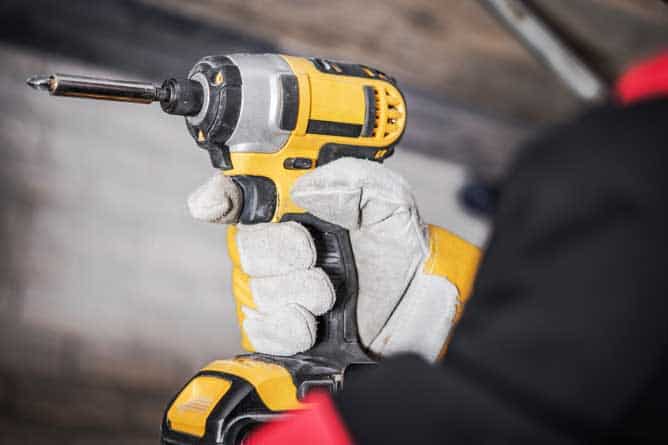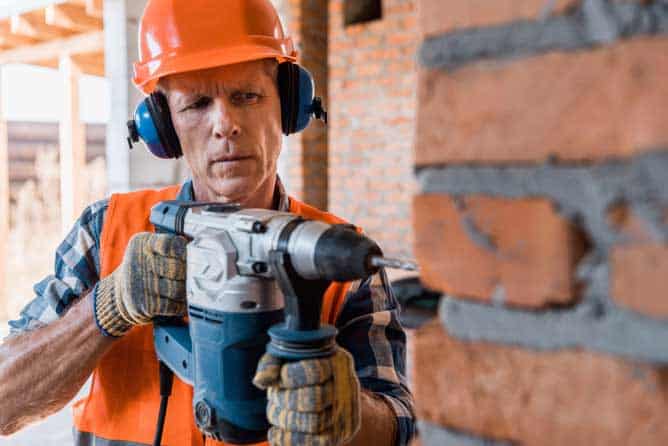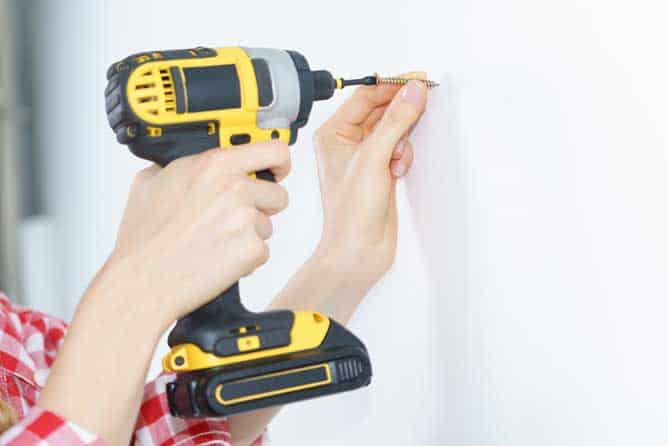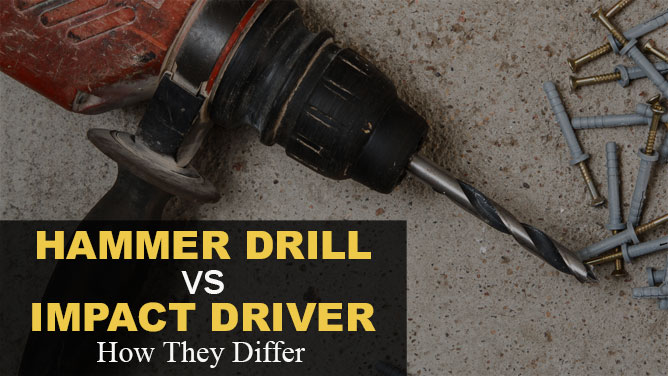Whether you’re a seasoned furniture building expert or dipping your toes in the waters of home remodeling for the first time, distinguishing between the endless variety of power tools in the hardware store is understandably hard.
When I first began home remodeling, I had a limited understanding of drills. I became extremely frustrated by retailers who did a poor job of explaining the differences between each drill. Admittedly, I’ve ended up purchasing tools I didn’t need.
Based on their external appearance alone, hammer drills are often mistaken for impact drills. But don’t be fooled–while they seem similar in appearance, there are several key distinctions between the two. If you’re anything like me, you probably have many questions about the hammer drill vs. impact drill driver’s differences.
I want to help you understand what each tool does, how it functions, and why you should choose the hammer drill vs. impact drill driver. Ultimately, you will be prepared to decide which tool is right for your next project.
ToolLogic.com earns a commission from purchases made through links in this post. Learn More
Impact Drill/Drivers
Impact drills, commonly known as “impact drivers,” are handheld drills designed to drive screws and drill holes speedily. These power tools can be corded or cordless, and both spins after you press a trigger. Their function is to push in or loosen long screws, bolts, and large fasteners into the material.
Impact drills are distinct from regular power drills because they use both percussion power and rotational force to push screws or fasteners into the material in mere seconds. These tools generate two to three times more torque than a drill in fast bursts.
Because they are usually lighter and more compact than regular drills, they are easier to use. The rapid pulsations can drive and extract tough screws, while a regular drill’s fixed torque might stop or stall out quickly.

What Is an Impact Drill/Driver Used For?
These power tools are perfect for installing decks, backboards, floors, or any project that necessitates inserting a screw or bolt into the wood. If your project requires large fasteners, an impact driver makes the job much more efficient. However, impact drivers are less fitting for more impenetrable materials like concrete, granite, marble, or brick.
Can an Impact Drill Driver Be Used For Concrete?
While it’s possible to drive a few holes in concrete, it can be much slower and more strenuous than using a hammer drill. If you’d rather attempt this instead of purchasing a hammer drill, remember to select drill bits that are sized correctly and specifically designed for an impact hammer to avoid breakage.
I’d suggest purchasing a rotary hammer drill for less resistant materials, which uses a forward thrusting motion with rapid front-to-back vibrations, to save energy and time. You can also choose a concrete drill, a hammer drill powered by a strong enough motor to drill through concrete and other tough materials.
Hammer Drills
Also known as “rotary hammers,” hammer drills are rotary drills with a forward-thrusting action. The rapid front-to-back vibrating motion while the drill-bit spins lets it fulfill its specific purpose of driving holes into masonry like rock, marble, granite, brick, concrete, and other hard materials.
While there are various types of hammer drills, such as concrete drills, they generally function the same. Each drill contains a hammering device that hammers the drill bit forward and lets the drill pummel its way through masonry.
If you’ve never used a hammer drill before, these drills typically have three modes determining their function.
- The “hammer” mode goes in a linear motion, similar to a jackhammer.
- The “drill” mode goes in a rotary motion like a normal drill.
- The “hammer-drill” mode uses a combination of both motions.

Can a Hammer Drill Be Used as a Regular Drill?
If you’re only planning to purchase one drill, you may want to consider a hammer drill, which can be operated as a normal drill if set in “drill” mode. Between a hammer drill and a regular drill, the hammer drill is more adaptable and can be used for a wider variety of purposes.
Hammer drills can be used to drill holes into more pliable materials like wood, but you don’t need to purchase a hammer drill for this reason. Because hammer drills are more powerful than regular drills, I recommend buying a regular drill if you’re only looking to drill holes into wood. You’ll save plenty of money by opting for a less expensive tool.
Granted, this is always the case. I recently had a conversation with a friend who was looking to purchase a new power tool. Because he’s just starting in home renovation, he wasn’t sure if he should purchase a regular drill or a hammer drill.
He mostly drills holes into concrete for his DIY home renovation projects, and he rarely drills wood. Unlike many people, his drilling has a more specialized purpose, so I suggested that he purchase a concrete drill instead of a regular drill, which I thought would offer more value and utility.
Hammer Drill Vs. Impact Drill Driver: What’s the Difference?
As we’ve explored, there are many similarities between a hammer drill and an impact drill. Don’t be fooled, though. If you take a more careful glance, you’ll soon discover that there are also major variances between the two.
Appearance and Design
Generally, hammer drills are typically heavier and larger, similar to a jackhammer, with a prolonged barrel. With a drill chuck that can take many types of bits and sizes, a hammer drill also features a three-jaw chuck, which is basically the drill’s front area that holds bits.
An impact driver is shorter and stockier, and while lacking a chuck, it has a hexagonal socket that can hold an adapter that can carry hex-shaped driver bits. Impact drivers are usually more stumpy, particularly near the barrel.

Function
A hammer drill and an impact drill are distinct because each tool wields force on its twisting action from a different direction. An impact driver raises the force that is exerted perpendicular to the bit, and a hammer drill applies additional force straight in the bit as it drills into the masonry.
An impact drill, which can be utilized for any project that needs a regular drill, is primarily used to drive in fasteners, including screws and nails. It might appear like a cordless screwdriver unless more power is required, and then a unique mechanism is activated and generates additional force.
Hammer Drill Vs. Impact Drill Driver: Which Should I Choose?
Essentially, if the majority of your projects require you to drill through heavy masonry, including bricks, concrete, marble, and granite, then consider investing in a hammer drill. If you’re looking for a power tool to drive or remove screws, nuts, and bolts on more malleable materials like wood, then I’d suggest purchasing an impact drill.
Should I Purchase Both?
I think DIY fans will discover that both tools are valuable, but the question of which drill is right for you will vary depending on the project type. Personally, I would purchase an impact driver if given a choice. Impact drills are more portable, less cumbersome, and a suitable option for everyday home renovation projects.
I think it’s important to get the most value when purchasing a new drill. Like many of you, I try to get the best bang for my buck, especially when buying expensive power tools.
If cost is a major factor, keep in mind that an impact drill is notably cheaper than a hammer drill, particularly the cordless model. However, I’d consider a hammer drill to be a good investment for tougher drilling projects. If you’d rather not buy an expensive hammer drill, you can rent one instead.
Hardware stores understand that these powerful tools may only need to be used on occasion, so many will allow you to rent tools and return them after you’ve finished using them. My advice is to take advantage of this option the next time you have to drill holes in concrete to save yourself a few bucks.
Finally, if you’re thinking about buying an impact or hammer drill, cordless drills are markedly lighter, which is easier on your hands and wrists. Because of their compact design, they are more portable and can be used in various places. You won’t have to worry about cords getting tangled or interfering with your drilling.
Final Thoughts
I hope that by reading this article, you’ve gained enough practical information to understand the differences between hammer drill vs. impact drill driver. With all of this in mind, I encourage you to carefully consider which tool is right for you and your project.
To sum it up, purchase a hammer drill if you’re looking to drill bricks, concrete, granite, marble, and another masonry. Opt for an impact drill/driver if you want to drive or remove screws, nuts, fasteners, and bolts.
As you continue to learn, I suggest reaching out to professionals at your neighborhood hardware store, as they can thoroughly address any other of your questions or concerns.
